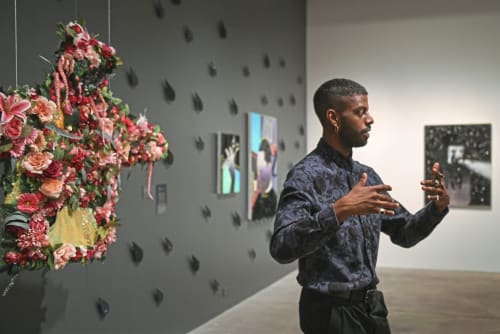Jessica Beck, Milton Fine curator of art at the Andy Warhol Museum, has three reasons why she wanted to bring Devan Shimoyama’s work to the Warhol after a studio visit with the artist two years ago.
“One, Devan is an extraordinary painter, two, it’s a really unique subject matter and, three, it had a really strong connection to Warhol’s legacy of pop, identity politics and also drag culture, specifically his 1974 to 1975 series he created called “Ladies and Gentleman” of drag queens and trans women in New York,” she says.
The Warhol Museum presents Shimoyama’s first solo museum exhibition with “Cry, Baby,” which opens Oct. 13 and runs through March 17, 2019. Shimoyama is currently the Cooper-Siegel Assistant Professor of Art in the School of Art at Carnegie Mellon University and was named the winner of the PULSE Prize at PULSE Miami Beach in 2016.
“Cry, Baby” uses self-portraiture to challenge contemporary views of African American masculinity and boyhood, turning a typically hyper-masculine social space into a queer fantasy with floral capes, glittery hair and skin in shades of green, gold and fiery red. This creates two worlds, according to Beck: a queer reimagining of an African American barbershop and a fantastic utopia.
“There’s a lot of challenging going around with what race looks like and can look like and that it doesn’t conform to societal standards of what race should look like,” she says.
The exhibition is accompanied by a catalog that includes essays by Beck, Alex Fialho, Programs Director at Visual AIDS, and Rickey Laurentiis, poet and resident at the University of Pittsburgh, and an interview with Shimoyama by Emily Colucci, a writer, curator and co-founder of Filthy Dreams, a blog analyzing art and culture through a queer lens.
According to Beck, the decision to include younger voices in the catalog was deliberate.
“Devan’s work is so reflective of the times we’re living in right now and reflective of the contemporary conversation around identity and youth culture right now and I wanted the writers to reflect that,” she says.
On top of that, Beck says the exhibition continues Warhol’s legacy of presenting contemporary themes and influencing—and being inspired by—pop and youth culture.
“Part of [Warhol’s] legacy is that he was always in touch with his current moment and he was always in touch with younger artists. It would be only fitting that the museum should reflect that,” she says.
According to Beck, she knew instantly that she wanted to present Shimoyama’s work at the Warhol after that casual studio visit two years ago. In this case, the risk was worth taking.
“It’s not often that you have a larger institution in a smaller city that wants to take a chance on an emerging artist that isn’t necessarily known by the broader art world, but this I think is a moment where that chance has paid off,” she says.

